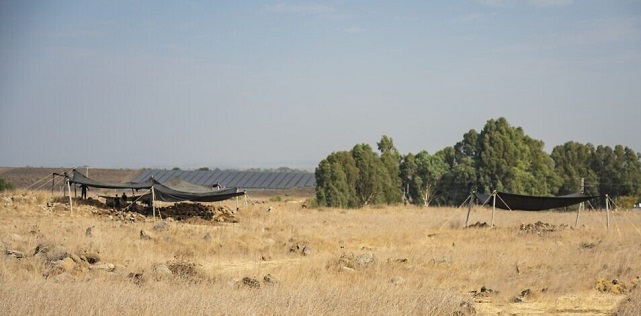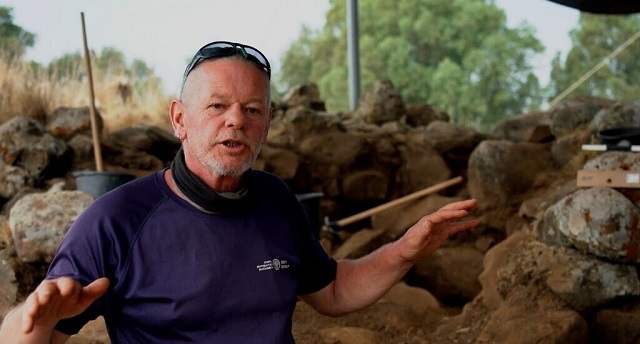Fort Dating From Time of King David Found In The Golan
1,00 year old jug filled with gold coins also found in Jerusalem.

The Israel Antiquities Authority excavation in the Golan (Yaniv Berman, Israel Antiquities Authority)
Archeologists from the Israel Antiquities Authority (IAA) have uncovered a fortified complex from the time of King David (Iron Age, 11th-10th centuries BCE) near the town of Hispin in the Golan Heights.
It is possible that the fort was manned by the Geshurites, who according to the Bible, ruled in the Southern Golan, and carried out diplomatic relations with King David and the Davidic Dynasty.
Excavation directors, Barak Zin and Enno Bron, said that, “the complex we exposed was built at a strategic location on the small hilltop, above the El-Al canyon, overlooking the region, at a spot where it was possible to cross the river.”
The find is significant for a number of reasons. First it may prove that accounts of King David recorded in the Bible are accurate. Historians and Biblical scholars alike have been skeptical about the events recounted in the Book of Samuel II seeing them as merely legends.
This attitude, of course, is not well received among religious people – both Jews and Christians – who will welcome the news.
But there is also a political component to the news. Israelis who do not wish to return the Golan to Syria as part of any peace deal can use this discovery to prove that Jews lived there as far back as the time of King David 3,000 years ago.

The Israel Antiquities Authority excavation at the Golan’s Hispin, (Yaniv Berman, Israel Antiquities Authority)
According to Jewish Encyclopedia, Geshur was a territory in the northern part of Bashan, adjoining the province of Argob (Deut. iii. 14) and the kingdom of Aram or Syria (II Sam. xv. 8; I Chron. ii. 23). It was allotted to the half of the tribe of Manasseh, which settled east of the Jordan; but its inhabitants, the Geshurites, could never be expelled (Josh. xiii. 13).
In the time of David, Geshur was an independent kingdom: David married a daughter of Talmai, King of Geshur (II Sam. iii. 3). Her son Absalom fled, after the murder of his half-brother, to his mother’s native country, where he stayed three years (ib. xiii. 37, xv. 8). Geshur is identified with the plateau called to-day “Lejah,” in the center of the Hauran. There was also another people called “Geshurites” who dwelt in the desert between Arabia and Philistia (Josh. xiii. 2 [A. V. “Geshuri”]; I Sam. xxvii. 8; in the latter citation the Geshurites are mentioned together with the Gezrites and Amalekites).
–
[embedded content]
Cities of the Kingdom of Geshur have been discovered by the Sea of Galilee shore, including Tel En Gev, Tel Hadar, and Tel Sorag, but few sites have been found in the Golan. So the archeologists say that the find of this unique fortified complex raises new research issues on the settlement of the Golan in the Iron Age.
The complex will be developed as an open area along the El-Al river bank, where educational-archaeological activities will be carried out, as part of the cultural heritage and a link with the past. We are astonished by these rare findings and grateful for the opportunity to experience work in the field and strengthen the young generation’s bonds with their roots.
The discovery in the Golan comes just days after an ancient jug filled with gold coins was found during an archeological dig in the Old City of Jerusalem. The coins date back 1,000 years.
The discovery of the jug was made by IAA inspector Yevgenia Kapil during preliminary digging at the site last month. Excavation director David Gellman found the coins when he emptied the contents of the jug.
“To my great surprise along with the soil, four shiny gold coins fell into my hand,” Gellman said. “This is the first time in my career as an archaeologist that I have discovered gold, and it is tremendously exciting.”
IAA’s coin expert, Dr. Robert Kool said, “The coins date from a relatively brief period, from the late 940s to the 970s CE. This was a time of radical political change. At the time, control over the area passed from the Sunni Abbasid caliphate, whose capital was Baghdad, Iraq, into the hands of its Shiite rivals, the Fatimid dynasty of North Africa, who conquered modern-day Egypt, Syria and Israel in those years.”
“The profile of the coins found in the juglet is a near-perfect reflection of the historical events,” he said. “Two gold dinars were minted in Ramla during the rule of Caliph al-Muti‛ (946–974 CE) and his regional governor, Abu ‛Ali al-Qasim ibn al-Ihshid Unujur (946–961 CE). The other two gold coins were minted in Cairo by the Fatimid rulers al-Mu‘izz (953–975 CE) and his successor, al-‘Aziz (975–996 CE).”





